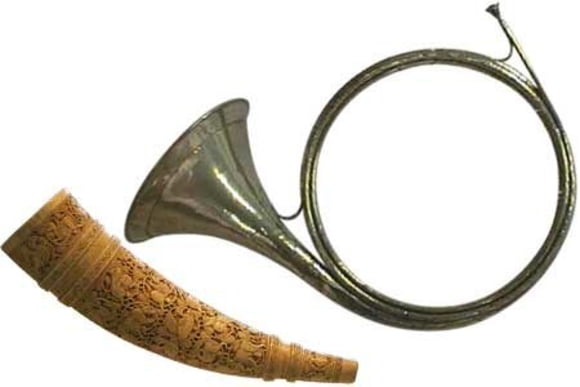2. History of the French horn
The first horns date back to prehistoric times. The instrument gets its name from its original form, which was made out of animal horns.
Alongside the drums, the horn is considered to be one of the oldest instruments in human history. Most early horns came from a group of animals known as Cavicornia (cattle, buffalos, goats, etc.).

Capricorn
In order to produce sounds, prehistoric horn makers broke off the tip of the animal horn (end-blown) or punched a hole in the side (side-blown). Similar instruments were made from tusks, hollow stems from plants, snail shells and sea shells.
Prehistoric humans used the horn as a signaling instrument, and they played it just like a modern-day player. Using their tightened lips, they created a vibrating air column inside the (most commonly curved) tube, making use of the same laws of physics as we do today. The pitch, length and intensity of the sound depended on the player’s lip tension and volume of the lungs.
From the Indian cow horn to the ancient Jewish Shofar, the curved horn was mostly used for rituals and ceremonies. The first metal horns date back to about 1600 B.C. and were discovered in the Middle East.
After the horn had gained popularity as a hunting instrument and hunters had begun to play polyphonic phrases on several horns tuned to each other, the instrument caught the attention of composers during the late Baroque period. Around the mid 18th century, the circular horn with two and a half windings and an overall length of at least seven feet transitioned from a narrow bore to a conical shape with a wide bell, and the cupped mouthpiece evolved into a conical shape. A tuning slide was added, which enabled players to change the tuning of the instrument and reach a wider range of notes. In order to play certain chromatic or diatonic notes, players began to insert their right hand into the bell of the horn. The hand-stopping technique gives the horn its warm and characteristic sound. But the horn still wasn’t able to play the full chromatic scale, until the first valved horns appeared at the beginning of the 19th century. Early varieties only had two valves. The first one lowered the harmonic pitch by a whole step, while the second one lowered it by a half step. Later, the Leipzig-based instrument maker Sattler added a third valve, which lowered the pitch by one and a half steps.

A consistent sound in different keys and the ability to play chromatically opened up new expressive possibilities for the horn in an orchestral context. The universal horn, which was most commonly tuned in F, required the player to transpose to different tunings. Even composers like Wagner and Verdi continued to write horn parts that required players to transpose. The hand-stopping technique, which had been developed to overcome the limitations of the natural horn, is still used to this day and has evolved into a unique method for shaping the sound and producing echo effects.
You’ll find more on this in the section on the horn’s sonic possibilities.




